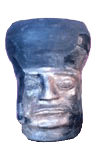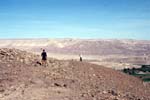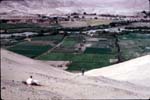 |
|
|
|
MOQUEQUA ARCHAEOLOGICAL SURVEY
(MAS)
|
The Moquegua Archaeological Survey
(continued)
In 1993, 1994 and 1995, the Moquegua Archaeological Survey (MAS) completed a full coverage reconnaissance of the middle drainage of the Rio Osmore, Peru, better known as the Moquegua Valley, in agreement with the Instituto Nacional de Cultura (INC 003-94-CNTCICMA/INC). Following standard full coverage survey techniques, both margins of the valley were walked by teams of archaeologists spaced at 20 m intervals. Over 450 site components, including domestic habitations, roads, agricultural works, geoglyphs and cemeteries were discovered, recorded on standardized forms, photographed, mapped, and located on regional maps. These included numerous small settlements of the Formative period, locally known as the Huaracane Phase (dated between 385 cal B.C - cal A.D. 340) located along the valley margins, and a smaller number of very large Tiwanaku culture sites of the middle Horizon (500-1000 AD.), located some distance from the valley margins. A small number of Formative and Tiwanaku sites also displayed minority components of materials from other cultures, including the Nasca, Pukara and Imperial Wari styles.
The second phase of the Moquegua Archaeological Survey
(MAS) complemented the initial settlement pattern data with detailed analysis
of selected sites. NSF Grant #SBR-9809720 supported my research in Peru
between August 1998 and September, 1999, conducted under INC C/060-98
and 415/INC. Work included site mapping, systematic surface collections,
test excavations and the analysis of collections curated in the Contisuyo
Museum of Moquegua. The larger research goals for 1998-1999 were to examine
a "multiethnic" model for the expansion of early states in the
Andes by focusing on: 1) population size and distribution in relation
to agricultural lands, 2) evidence of site specialization and administrative
hierarchy and, 3) evidence of political, cultural or ethnic coexistence
among groups like indigenous Formative/Huaracane agriculturalists and
Wari and Tiwanaku colonists.

|

|
Copyright ©2003 Paul S. Goldstein.
All rights reserved.
|




